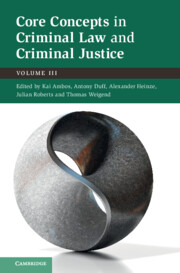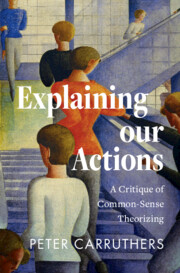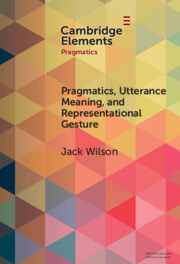Refine search
Actions for selected content:
117 results
12 - Sin and Evil
- from Part II - Theological Themes
-
-
- Book:
- The Origins of Scholasticism
- Published online:
- 18 November 2025
- Print publication:
- 08 January 2026, pp 333-360
-
- Chapter
- Export citation

Deception and Self-Deception
- A Unified Account
-
- Published online:
- 31 July 2025
- Print publication:
- 04 September 2025
-
- Element
- Export citation
3 - Intention
- from Part I - Criminal Law
-
-
- Book:
- Core Concepts in Criminal Law and Criminal Justice
- Published online:
- 09 July 2025
- Print publication:
- 24 July 2025, pp 55-95
-
- Chapter
- Export citation
A Functional Analysis of Self-Deception
-
- Journal:
- Journal of the American Philosophical Association / Volume 11 / Issue 4 / December 2025
- Published online by Cambridge University Press:
- 17 July 2025, pp. 730-749
-
- Article
-
- You have access
- Open access
- HTML
- Export citation

Core Concepts in Criminal Law and Criminal Justice
- Volume III
-
- Published online:
- 09 July 2025
- Print publication:
- 24 July 2025
Chapter 5 - Decision-Making and Goals
-
- Book:
- Explaining our Actions
- Published online:
- 17 April 2025
- Print publication:
- 08 May 2025, pp 91-113
-
- Chapter
- Export citation
Chapter 6 - Pleasure and (Affective Forms of) Desire
-
- Book:
- Explaining our Actions
- Published online:
- 17 April 2025
- Print publication:
- 08 May 2025, pp 114-134
-
- Chapter
- Export citation
45 - Legislatures
- from Part III. C - The Democratic System
-
-
- Book:
- The Cambridge Handbook of Constitutional Theory
- Published online:
- 27 March 2025
- Print publication:
- 24 April 2025, pp 792-809
-
- Chapter
- Export citation

Explaining our Actions
- A Critique of Common-Sense Theorizing
-
- Published online:
- 17 April 2025
- Print publication:
- 08 May 2025
Chapter 3 - Manipulation: The Anatomy
- from Part I - The Concept
-
- Book:
- The Concept and Ethics of Manipulation
- Published online:
- 10 April 2025
- Print publication:
- 17 April 2025, pp 79-116
-
- Chapter
- Export citation
5 - Beyond the Qualificational Hierarchy
-
- Book:
- Modality in Mind
- Published online:
- 25 March 2025
- Print publication:
- 27 March 2025, pp 152-194
-
- Chapter
- Export citation

Pacifism and Non-Violence in Contemporary Islamic Philosophy
- Mapping the Paths of Peace
-
- Published online:
- 13 March 2025
- Print publication:
- 20 March 2025
-
- Book
-
- You have access
- Open access
- Export citation
Pierre d'Auriol et la théorie des deux sujets de l'intellection. Une lecture d'Averroès
-
- Journal:
- Dialogue: Canadian Philosophical Review / Revue canadienne de philosophie / Volume 63 / Issue 3 / December 2024
- Published online by Cambridge University Press:
- 23 January 2025, pp. 541-555
-
- Article
-
- You have access
- Open access
- HTML
- Export citation
4 - Faking Marriage
- from Part I - Marriage
-
- Book:
- Inducing Intimacy
- Published online:
- 26 October 2024
- Print publication:
- 07 November 2024, pp 88-118
-
- Chapter
- Export citation
Factors influencing the intention of young adults to adopt genotype-based personalised advice on diet and physical activity according to perceived weight status
-
- Journal:
- Journal of Nutritional Science / Volume 13 / 2024
- Published online by Cambridge University Press:
- 30 September 2024, e54
-
- Article
-
- You have access
- Open access
- HTML
- Export citation
Chapter 3 - The Expert Transition Cycle
- from Part I - Transitions
-
- Book:
- Transition Expertise and Identity
- Published online:
- 30 May 2024
- Print publication:
- 06 June 2024, pp 23-36
-
- Chapter
- Export citation
Within- and between-person associations of time-varying determinants with snacking in older adults: an ecological momentary assessment study
-
- Journal:
- British Journal of Nutrition / Volume 132 / Issue 2 / 28 July 2024
- Published online by Cambridge University Press:
- 20 May 2024, pp. 236-247
- Print publication:
- 28 July 2024
-
- Article
-
- You have access
- HTML
- Export citation
The Primacy of the Practical
-
- Journal:
- Canadian Journal of Philosophy / Volume 53 / Issue 4 / May 2023
- Published online by Cambridge University Press:
- 13 May 2024, pp. 301-314
-
- Article
-
- You have access
- Open access
- HTML
- Export citation
5 - Intentionalism
-
- Book:
- Demystifying Treaty Interpretation
- Published online:
- 07 March 2024
- Print publication:
- 14 March 2024, pp 101-117
-
- Chapter
- Export citation

Pragmatics, Utterance Meaning, and Representational Gesture
-
- Published online:
- 02 February 2024
- Print publication:
- 29 February 2024
-
- Element
- Export citation
